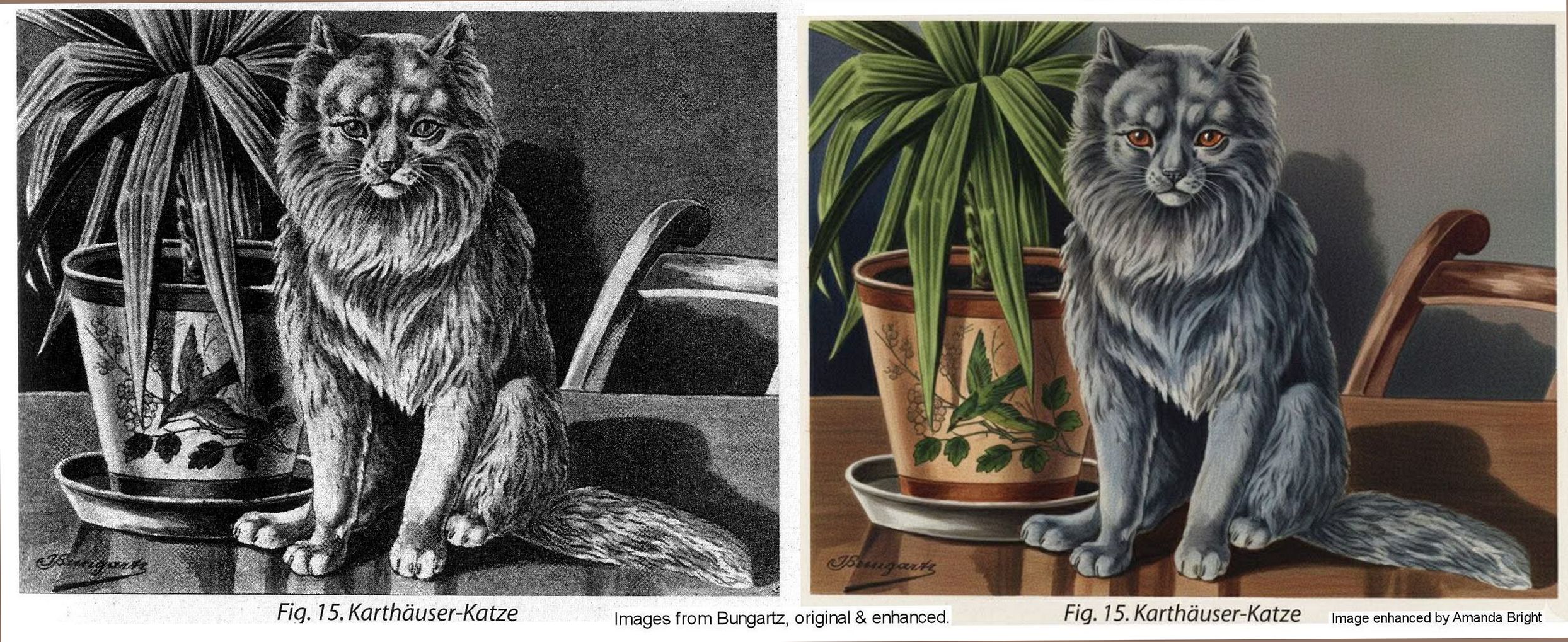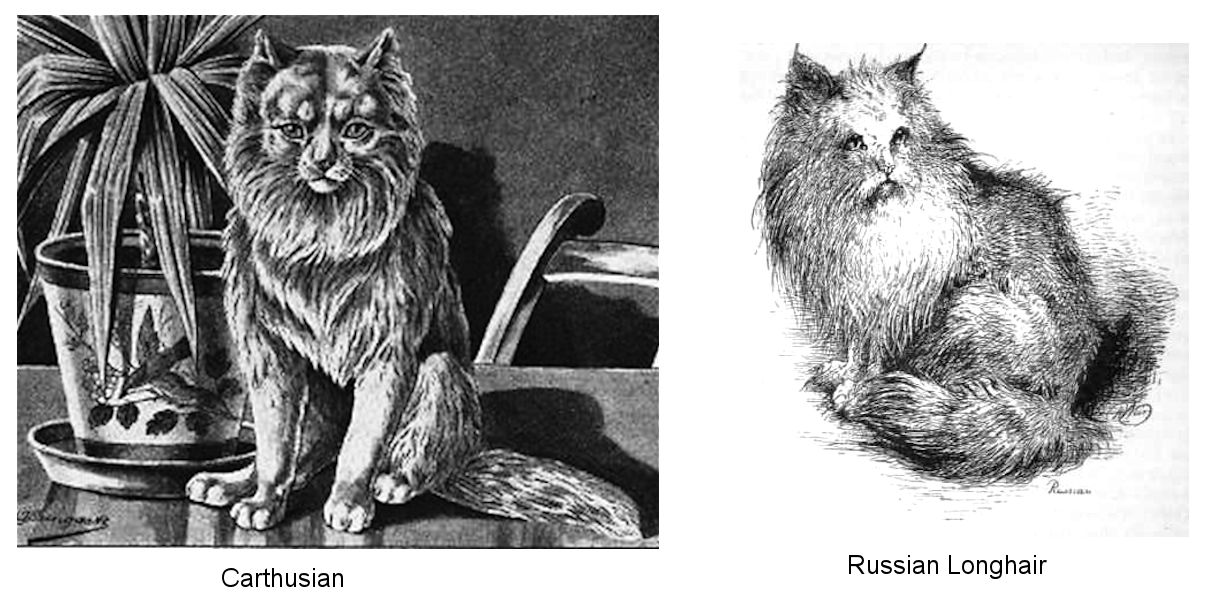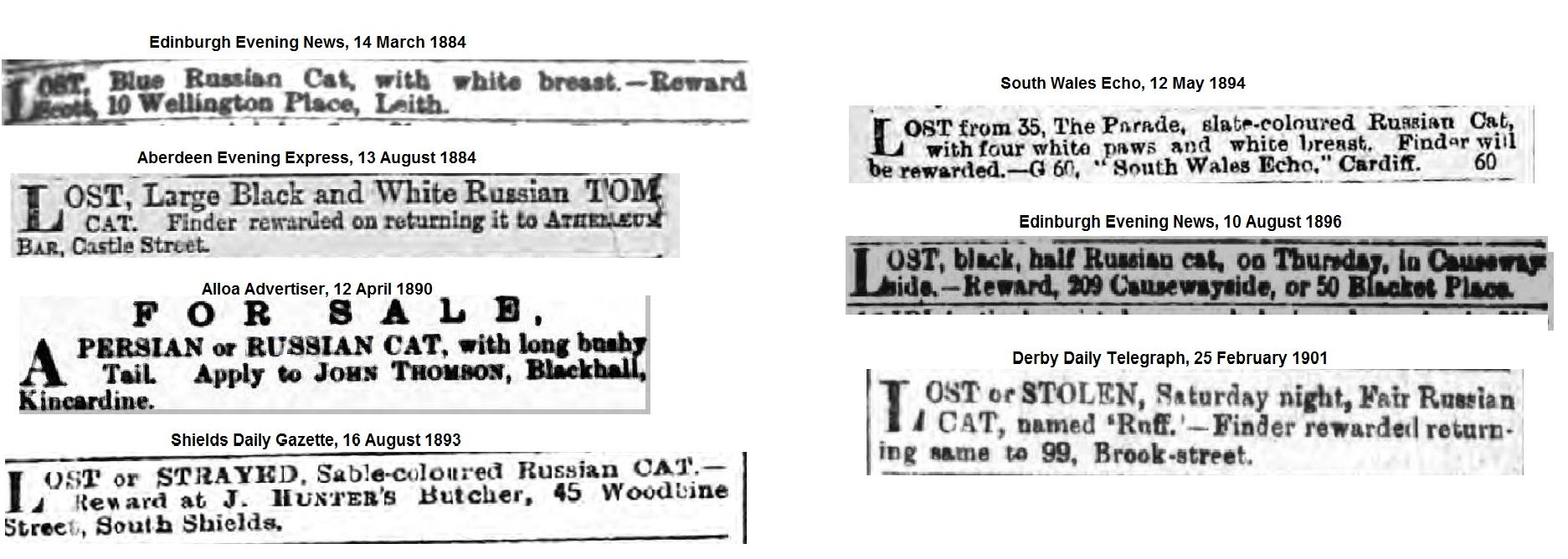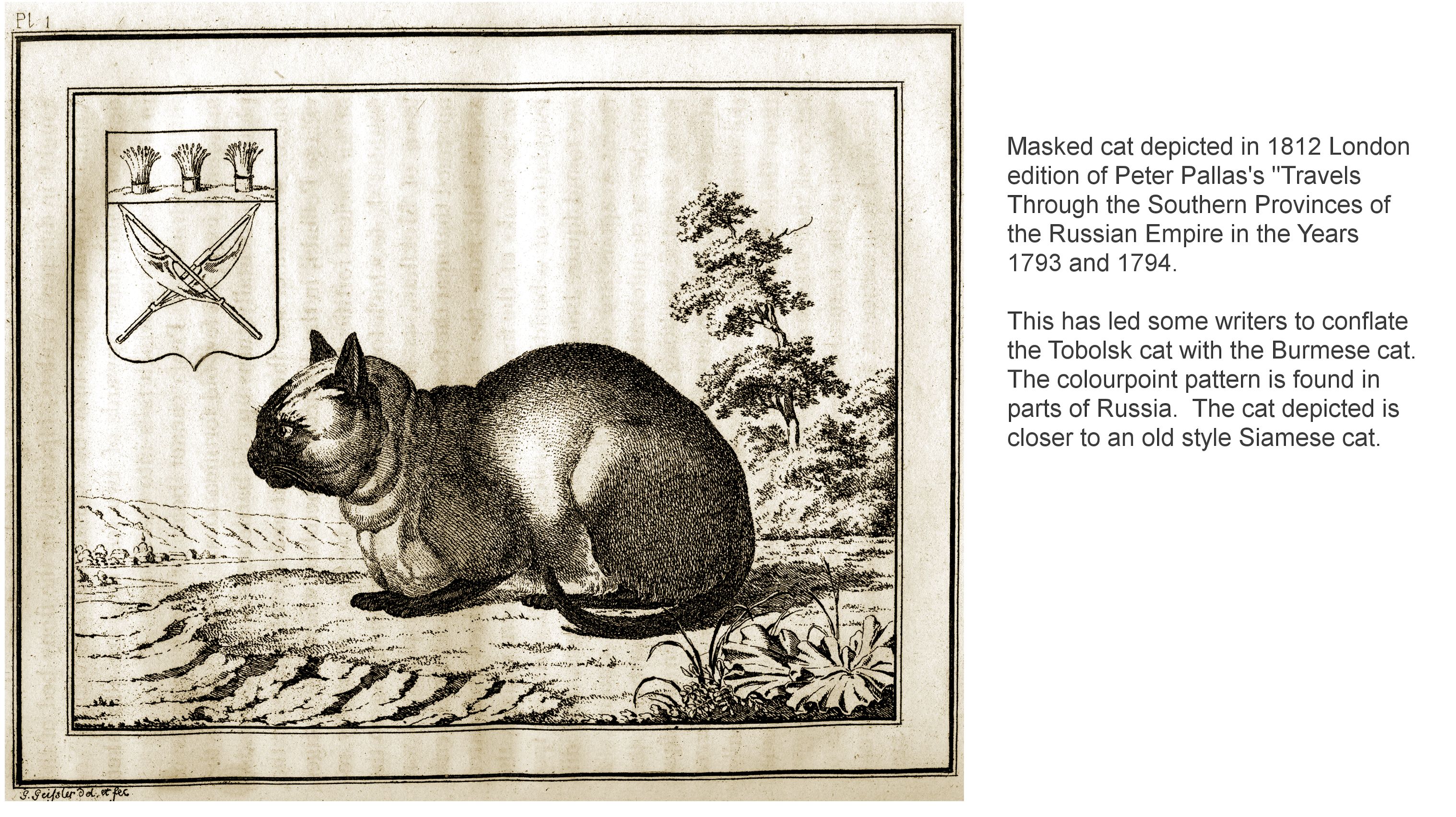
LOST BREEDS - RUSSIAN LONGHAIR, CARTHUSIAN, TOBOLSK, KAZAN & CRIMEAN CATS
These "breeds" probably refect the great confusion over where certain cats came from and what names they should be given. There was also a race by naturalists to discover new species - and if species weren't available then a new subspecies or breed would suffice. Naturalists from different countries independently found and described the same varieties and gave them different names. Hence these "lost" breeds are probably not actually lost, they are now known under different names.
CARTHUSIAN CAT

In 1896, Jean Bungartz wrote is his "Illustrated Book of Cats" (in German only): The Carthusian cat is a self-coloured blue variety with long fine hair, black lips and soles. The blue colour varies from bluish ash-grey to bluish. If the colour is pure and the hair is in good care, then the Carthusian is considered a most magnificent animal, but its character is somewhat phlegmatic, a characteristic it shares with other longhair cats: the Angora, the Persian and the Chinese cat. Iceland or Kumani cat and similar designations are, are almost identical to the previous variety. The Iceland cat is characterised by beautiful bluish grey colouring of the skin; the Kumani cat, originating from the Caucasus, however have thick hair of white, black or rust-red color; lips and soles are flesh colour ...The following cats may be so similar to the common housecat that they differ only by colouring. For example, the cat of Iceland is beautifully bluish gray, the Tobolsk cat from Siberia is red or fox-colored, those from the Cape of Good Hope are blue or red."
In 1926, Dr Jumaud's book "Les Races des Chats" (The Breeds of Cats), which was based largely on the works of Professor Cornevin of Lyons, described the Carthusian cat (felis catus carthusianorum) as rare in England and France, but common in the United States under the name "Maltese cat". Jumaud wrote "It is found in Russia where it forms the sub-varieties of Tobolsk, Korassan, or Caucasus. It is one of the races which can live in the low temperatures of high mountain districts. [ ] During the brief Russian summer they wander in the woods infested with venomous insects; in winter they are imprisoned between the four walls of a snow-covered cabin, constrained to domestic life until the thaw comes. Many of the furs which reach us from Russia are really made from the skins of these cats. The Carthusian cat has a tendency to laziness; it is, however, a good hunter. Head large, with large and full eyes, small and erect ears, short nose. Coat, half long and woolly, and it is this woolly consistency which forms the principal characteristic of the breed, and is found even in specimens whose fur is not long. Colour uniform grey, with bluish reflections, in the proper Carthusian breed, reddish in the Tobolsk variety."
In 1927, HC Brooke noted "In America, the blue short-hair is commonly known as the Maltese cat; whilst many older English writers call it the Carthusian." However, Signor de Southoff, from Florence, wrote of beautiful long-haired red cats he had seen at Viege, above Aigle, Canton Vaud, in Switzerland, claiming these to be Carthusian cats with beautiful heads and furs.
In his book Just Cats (1957), French cat-fancier Fernand Mery reported Jumaud thus: "Only twenty-five years ago Dr. Jumaud, in his inaugural lecture before the Faculty of Medicine of Lyons, gave the names of American cat and Maltese cat to the Chartreux cat (catus Carthusianorum): They are also found in Russia, he said, where they form the sub-breeds of Morossan and Caucasian. So the confusion was extreme, even among the greatest specialists of the time. Today, Blues are distinctly classified, although their description and the scale of points of each is based on the classic Chartreux." He added that the thick, soft, close fur of the Russian Blue and Chartreux was exploited by the fur industry.

RUSSIAN LONGHAIR
Harrison Weir, founding father of the cat fancy and organiser of the first formal cat show (also writer of the first standards for pedigree cats), wrote about the Russian Longhairs in "Our Cats" in 1889. The cat he described differs from the modern Siberian cat, for example it was woollier, although cats of the old Russian Longhair type apparently still exist among domestic longhairs in parts of Russia. The Russian Longhair male described by him differed from the Angora and the Persian, being "larger in body with shorter legs. The mane or frill was very large, long, and dense, and more of a woolly texture, with coarse hairs among it; the colour was of dark tabby, though the markings were not a decided black, nor clear and distinct; the ground colour was wanting in that depth and richness possessed by the Persian, having a somewhat dull appearance. The eyes were large and prominent, of a bright orange, slightly tinted with green, the ears large by comparison, with small tufts, full of long, woolly hair, the limbs stout and short, the tail being very dissimilar, as it was short, very woolly, and thickly covered with hair the same length from the base to the tip, and much resembled in form that of the English wild cat."
According to Weir, its motion was less agile than other cats and it did not care for warmth, preferring to be outdoors in the coldest weather. Another peculiarity was that it seemed uninterested in hunting birds. Its habits were not like those of its companion shorthaired cats. It attached itself to no person, but was inseparable from a shorthaired, silver-gray tabby female. This pair produced a single black-and-white kitten. The kitten inherited the woolly coat, had somewhat of a mane and a short bushy tail. It also seemed uninterested in birds, but would attack rats!
"I have seen several Russian cats, yet never but on this occasion had the opportunity of comparing their habits and mode of life with those of the other varieties; neither have I seen any but those of a tabby colour, and they mostly of a dark brown. I am fully aware that many cross-bred cats are sold as Russian, Angora, and Persian, either between these or the shorthaired, and some of these, of course, retain in large degree the distinctive peculiarities of each breed." However to the practised eye, it was possible to distinguish whether the cat was Angora, Persian of Russian. Unfortunately, these were all judged together in a longhaired class and not as distinct breeds; something which ultimately led to the loss of the Angora and Russian types. I have seen some 'first-cross cats' that have possessed all, or nearly all, the points requisite for that of the Angora, Persian, or Russian, while others so bred have been very deficient, perhaps showing the Angora cross only by the tail and a slight and small frill. At the same time it must be noted, that, although from time to time some excellent specimens may be so bred, it is by no means desirable to buy and use such for stock purposes, for they will in all probability 'throw back' - that is, after several generations, although allied with thoroughbred, they will possibly have a little family of quite 'short-hairs'. I have known this with rabbits, who, after breeding short-haired varieties for some time, suddenly reverted to a litter of 'longhairs'; but have not carried out the experiment with cats."
Weir noted that he had never seen tabbies among the shorthaired Russian cats, but the Russian Longhairs were all brown tabbies except for two black Russian Longhairs, which he supposed were the offspring of tabby or grey parents. He did not recall having seen any white Russian Longhairs and wrote "I should feel particularly obliged to any of my readers who could supply me with further information on this subject".
It was also known as the Russian Angora, the term "Angora" simply meaning "long-haired." The description indicates a forerunner of the rather rugged Siberian cat although the breeders of the daintier semi-longhaired Nebelung (the semi-longhaired cousin of the Russian Blue claim it as the inspiration for their breed. Nebelungs are found only in a blue-grey colour, but the adverts below show that Rusian Longhairs occurred in a variety of colours.

Another description of the Russian cat can be found in news reports from September 1894 regarding thefts of Russian cats (sources: A Most Remarkable Cat - Western Gazette, 21st September, 1894, A Cat Which Went Astray. Sequel In County Court, Hartlepool Northern Daily Mail, 6th July 1894). A case came up at the Hartlepool County Court where Wm. Henry Hardy and H. Elgie disputed the ownership of a cat in Elgie s possession. Hardy claimed that the animal belonged to him and sued Elgie for 5 or the return of the cat. Hardy stated that he owned several Persian cats. A black Tom cat, was missing. When a kitten had won a third prize at a local show, whilst its mother, which he had bought for 2, took a second prize at the Crystal Palace in 1892. He would recognise the cat, because its tail was broken it about an inch from the end. On the 19th May 1894 he sent it to live with his mother, but on May 30th the cat was in Mr Elgie's possession. He stated that the cat was a pure Persian. Counsel for the defence asked Would you be surprised to hear that it was a Russian cat? to which Hardy replied It does not matter whether is Russian or not; it is a Persian cat. (Laughter.) This tells us that the 1890s Russian cat was, to the layman at least, indistinguishable from the Persian cat of that time.<.P>
TOBOLSK
Of the Tobolsk cat, Jumaud wrote, "This variety, described by Gmelin, exists in Siberia, and is sometimes called the Tobolsk cat. It is larger than our common cat, and somewhat resembles the Carthusian in shape. The head is large, with big eyes, short nose, and small erect ears. Coat: as is fitting for an animal of a cold country, the Tobolsk cat has long fur, longer than that of the Chartreuse cat. Its texture is woolly, and in colour, uniformly reddish." In his book Just Cats (1957), French cat-fancier Fernand Mery described the grey-blue Russian cat as having "nothing in common with the so-called Tobolskan" cat with its medium-long reddish hair".
These are all second-hand accounts. What did Johann Georg Gmelin say about the cat? In his Trip through Siberia; 1st part 1733-35 from A Collection of New and Strange Surneys; 4th part he wrote Tobolsk - Stadt der K he, der Faulenzer und des Vergn gens (Tobolsk - city of cows, idlers and pleasure) - Von den Katzen habe ich noch dieses als was Besonderes angemerkt, da sie hier meistens rot sind. (Of the cats I have especially noted that they are mostly red here.)
Confusingly, in the American "Cats Magazine" of August 1977, guest editor Jolie Smith conflated the Burmese with the Tobolsk cat. She wrote "The Burmese cat originated in the area of Tobolsk in Russia, and many naturalists of the last century have described a brown cat with gold eyes as being indigenous to that area. Tobolsk was on the old caravan route leading down into Burma and Thailand. These cats bred with garden variety cats and followed the caravans in search of food and warmth. Many migrted to this area. 'Burmese' is a man-made title because the first was imported from Burma. All this information can be found in the Jewel City Cat genetics Library in Glendale, California." This seems to relate to a picture of a cat from the 1812 London edition of Peter Pallas's "Travels Through the Southern Provinces of the Russian Empire in the Years 1793 and 1794." The engraving was made by Christian Gottfried Heinrich Geissler who had accompanied Pallas on his travels through Russia. The coat of arms is that of Mokshan, a small town in Penza province.

KAZAN
Then there was the Kazan cat which had either a black coat or silvery blue coat with blue extremities (black or blue smoke) and resembled the Turkish Angora. It supposedly shared its ancestry with the Angora as Kazan was an independent Tartar empire that traded with the Turcoman people from Khorassan.
CRIMEAN CAT
The Crimean cat was pure white with a coat is shorter than that of an Angora. Van der Werff believed this was due to hybridization with cats from Rumania and Poland. The Crimean was already extremely rare between 1853 and 1856, and was probably extinct by the time of the organised cat fancy.
BUKHARA
The Siberian type of cat was first mentioned in 16th century sources and was known as Bukharskie because reached Russia from the large commercial town of Bukhara, in Uzbekistan. Longhaired cats were known and popular throughout tsarist Russia more than 200 years ago, but were not known as Siberians. Through interbreeding, some Siberian cats came to resemble the Bukhara, but the ancestors of the Siberian cat reputedly reached Siberia together with the Cossacks in 1582 led by Ermak Timofeevich, and interbred with native wild cats (F lybica type).
In Sketches of Khiva Oasis of Nature (Tashkent, 1882) on the local cats, the Soviet zoology professor DN Kashkarov wrote that Occasionally Longhair cats are imported from Bukhara ... and he suggested the Reed cat (F chaus) and the Pallas cat (Manul) were ancestors of the Siberian and Bukhara respectively in his book Animals of Turkestan (Tashkent State University, 1932) although this is now considered genetically unlikely.
The Central Asian longhaired cat was taken from Bukhara to Siberia and the East, and travelled westwards with Asian traders, crossing the Caspian Sea and travelling further up the Volga, and along trade routes to Moscow. In his 1913 book Among the Shifting Sands and Severed Heads. Travel Essays of Turkestan, the Swedish-born Russian traveller VN Garteveldom (Napoleon Hartevelde Julius Wilhelm, later William Napoleonovich Garteveldom) mentioned the Bukhara cat in the chapter Bukhara: The famous and, indeed, very beautiful and graceful Bukhara cats are also sold here and are not cheap. A couple of good specimens (male and female) cost from 75 to 100 roubles. The collapse of the Russian Empire affected its former trading partners in Central Asia. Bukhara was no longer an important trade crossroads. Muscovites who remembered Moscow before the 1917 revolution recalled high prices being paid for these large, fluffy cats with their ear tufts, and recalled seeing them around the city.
While written sources confirm the existence of both the Siberian and Bukhara types, and their different places of origin and different routes into Russia, by the end of the 20th century the Bukhara cat appeared to have been forgotten in Russia and was never picked up by American or British cat fanciers despite mentions of the various Russian cats by Gmelin, Brehm etc. The Bukhara cat from Asia eventually became an ancestor of the Siberian, the latter name being associated with strength and rugged character.
Notes
The Russian Longhair type is represented on the modern show-bench by the Siberian, while the Carthusian is represented by the Chartreux, rather than the modern Russian Blue.